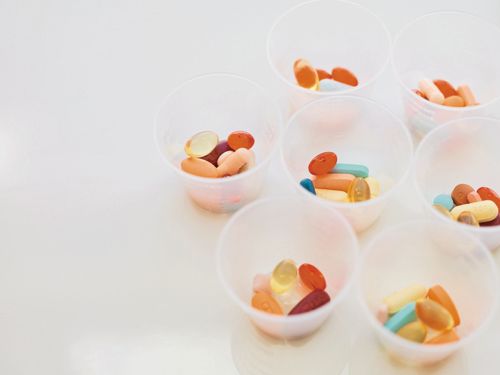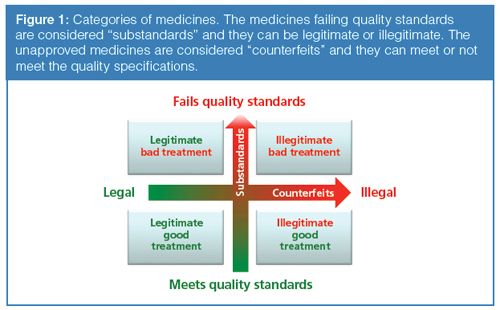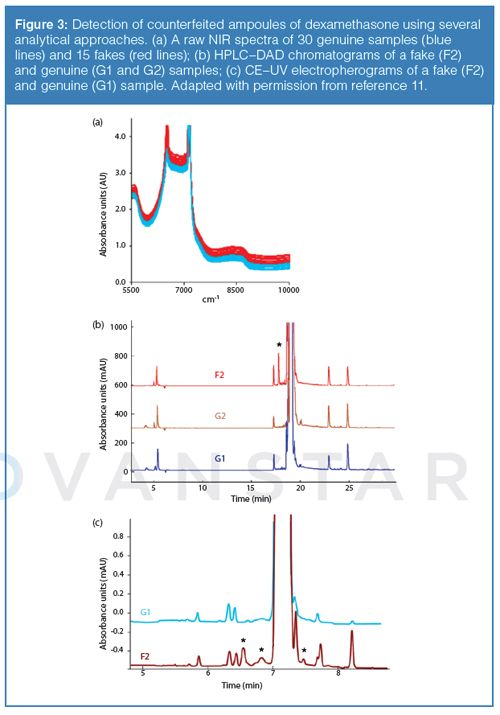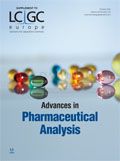Characterization of Counterfeit and Substandard Medicines Using Capillary Electrophoresis
Special Issues
The proportion of counterfeit medicines has increased dramatically. Combatting this issue is complex, and various levels of action are necessary. The quality control (QC) of imported batches using simple, reliable, and cost-efficient analytical approaches is vital. Capillary electrophoresis (CE) is becoming important because the analysis is achieved in a capillary with small dimensions, and is usually filled with an aqueous buffer. No organic solvent is required and injection volumes are in the nanolitre range, which is convenient because of the low availability of reference substances and reduces the environmental impact. CE is now recognized by numerous Pharmacopeia and can be used for counterfeit and substandard characterization as a validated analytical procedure that adheres to international guidelines.
Photo Credit: Hero Images/Getty Images

Julie Schappler and Serge Rudaz, School of Pharmaceutical Sciences, University of Geneva, University of Lausanne, CMU, Geneva, Switzerland.
The proportion of counterfeit medicines has increased dramatically. Combatting this issue is complex, and various levels of action are necessary. The quality control (QC) of imported batches using simple, reliable, and cost-efficient analytical approaches is vital. Capillary electrophoresis (CE) is becoming important because the analysis is achieved in a capillary with small dimensions, and is usually filled with an aqueous buffer. No organic solvent is required and injection volumes are in the nanolitre range, which is convenient because of the low availability of reference substances and reduces the environmental impact. CE is now recognized by numerous Pharmacopeia and can be used for counterfeit and substandard characterization as a validated analytical procedure that adheres to international guidelines.
The ever-growing problem of drug purity and counterfeit medicine needs to be addressed. It is estimated that an important portion of all world trade in branded pharmaceutical products is counterfeit, leading to a great health risk and public health concern. As witnessed by numerous official sources, including the World Health Organization (WHO), the proportion of counterfeit medicines has tremendously increased, representing more than 50% in some developing regions of the globe (1). The primary reported cases of counterfeits are affiliated to emerging countries, where economically middle-income markets are most represented (that is, Sub-Saharan African countries, as well as Asian and Latin American regions). According to health-related government agencies, the most prevalent therapeutic category affected by counterfeits is anti-infectives (21.1%), with the much needed antibiotic, antiparasitic, and antiretroviral medicines (2). Discovering and determining counterfeit drugs is mandatory not only for these countries, but also for others, particularly when considering the internet market (3). In order to characterize counterfeit and substandard medicines (Figure 1), different levels of action can be applied. The evaluation of the packaging based on a comparison with the genuine sample and the search for manipulation signs is appropriate for detecting counterfeits, whereas chemical methods should be implemented to authenticate the samples and provide the chemical composition of substandards (7).

Characterization of Counterfeit and Substandard Medicines with Chemical Analysis
There is an urgent need to set up tools and workflows to fight against counterfeit and substandard medicines and their associated health risks. Evaluating the quality of active pharmaceutical ingredients (APIs) and excipients usually requires a broad variety of modern analytical methodologies, allowing the qualitative and quantitative determination of the content and the purity of the drugs (8).
Methods for qualitative analysis include basic but critical physical, organoleptic, and haptic tests, as recommended by international Pharmacopoeia. Colorimetric assays using chemical assays reacting with functional groups is another traditional way to identify drug compounds, although false-positive results may be obtained because of the low specificity of such assays, circumventing the determination of structurally similar molecules, such as impurities. These tests are therefore mainly implemented as a first and rapid screening to establish only the presence versus absence of an API in a medicine. Spectroscopic techniques, such as Raman, near infrared (NIR), and nuclear magnetic resonance (NMR) spectroscopy, are used to control the quality of pharmaceuticals because they provide a wealth of information on the molecular structure of the APIs and excipients, as well as on their spatial distribution. Separation techniques, such as thin-layer chromatography (TLC), high performance liquid chromatography (HPLC), gas chromatography (GC), and capillary electrophoresis (CE), are more selective assays and can be used for qualitative as well as quantitative determination. They are fully established and have been added to almost all monographs of major Pharmacopoeia for quality control (QC) purposes. The higher selectivity of hyphenated techniques (that is, with mass spectrometry [MS]) offers detailed pictures of an analyte or an analyte mixture, while the structure of unknown contaminants can be elucidated and determined in very small quantities. In modern QC laboratories these analytical instruments are mostly available, allowing for an extensive product testing during production and during the distribution within the respective supply channels. However, they need trained people to use them and samples generally need to be brought to the laboratory to be analyzed.
In emerging countries, comprehensive QC of circulating medicines is hardly achieved because of relatively young healthcare systems, restricted laboratory capacities, weak analytical infrastructures, and chaotic distribution logistics. Therefore, a sequential approach is recommended, according to the goal of the analysis, the localization of the laboratory, and the overall technical skills of the analyst (Figure 2). In a first approach, a large screening can be performed with a nondestructive method, for example, vibrational spectroscopy (Raman, NIR). These methods give rapid and low false-negative results, can be brought to the field where the samples can be tested, are sufficiently easy to handle by people with little training, and can be conducted without special, or reduced, sample preparation (9). When a sample does not comply in terms of identity or quantity, a confirmatory analysis should be done with an orthogonal approach, such as that afforded by separation techniques. As previously mentioned, separation-based devices including GC, LC, or CE are often not portable, therefore the suspicious samples are generally brought to the laboratory where the analysis takes place by trained people (10).

Rodionova et al. applied the sequential approach for the detection of counterfeited ampoules of dexamethasone (11). First, NIR measurements with chemometric data processing were performed directly in the closed ampoules of the injectable formulations. The technique was able to detect small differences in the samples and emphasized reliable discrimination between genuine and counterfeit samples, using a modelling set that included samples from various batches (Figure 3[a]). Samples were then subjected to GC–MS, HPLC coupled to a diode array detector (DAD), and CE coupled to an ultraviolet (UV) detector for confirmation. GC–MS did not find any differences between genuine and fake samples, avoiding the discrimination between both samples. HPLC–DAD revealed that samples from different batches were identical, but for some impurities they differed in quantity. A new impurity (marked with an asterisk) was found in a fake sample (Figure 3[b]) and MS was further applied for its identification. According to the high efficiency and orthogonal selectivity of the separation, CE–UV reliably found three impurities in the fake sample that were not present in the genuine sample (Figure 3[c]). In this study, the CE method showed the most informative results for discriminating samples with close chemical composition.

As can be seen from this study, chromatographic approaches can be applied for the confirmatory analysis, but they suffer from several drawbacks that often hamper their use in emerging countries: (i) they are expensive to acquire, maintain, and run; (ii) high amounts of reference material and organic solvents are needed; (iii) the consumables and the chemicals may be prohibitive and difficult to obtain.
In this context, CE has a role to play in this fight because it offers a low consumption of sample and reference material, little use of organic solvent, affordable consumables and maintenance, and a basic requirement of chemistry knowledge.
Characterization of Counterfeit and Substandard Medicines Using Capillary Electrophoresis
The well-established CE technology can be applied for the characterization of counterfeit and substandard medicines. In this article we present several CE applications, as well as developments that were made in this context towards the instrumentation and the methods.
Applications: Vidal et al. developed a method based on CE coupled to capacitively coupled contactless conductivity detection (C4D) for the determination of an important counterfeited medicine, sildenafil, used for treating erectile dysfunction (12). Experiments were performed with a laboratory-made CE device equipped with two C4D detectors in series. The first detector afforded a low efficiency but fast detection, while the second detector was used to obtain higher efficiency results. The background electrolyte (BGE) was made of acetic acid 0.5 M and the capillary was coated prior to a series of analyses with a cationic coating to prevent analyte adsorption on to the capillary wall. An interesting feature of C4D detection was the possibility to detect in the same run, not only sildenafil, but also its associate salt (citrate). Thus, commonly counterfeited tadalafil or vardenafil tablets (which should be exempt of citrate) containing sildenafil could be easily detected.
Antimalarial drugs are another major class of counterfeit medicines that are dramatically present on the African market. Lamalle et al. developed a CE–UV method for 15 antimalarials (13). As these molecules cannot be ionized at the same pH, micellar electrokinetic chromatography (MEKC) was preferred over capillary zone electrophoresis, allowing the separation of neutral compounds. Preliminary experiments were first performed to select the most crucial factors (including pH, surfactant concentration, acetonitrile proportion, and temperature). Next, an experimental design methodology was applied to enable the prediction of optimal conditions for best analyte separation in less than 8 min. Finally, the method was successfully applied to the quality control of African antimalarial medicines for their qualitative and quantitative content. At the same time, another European laboratory developed a MEKC–UV method for artesunate and amodiaquine in fixed-dose combination tablets (14).
Capillary electrophoresis was also used to determine adulterants in pharmaceuticals. De Carvalho et al. applied CE–C4D for the determination of adulterants in herbal weight loss products collected in pharmacies located in different Brazilian states. A first study emphasized that either anxiolytics, diuretics, or laxatives were added to 4% of the weight products collected (15). In a second study, CE analyses revealed that more than 30% of the analyzed formulations were found to contain diuretics in the final composition (16). These drugs have a low incidence of side effects, but are associated with several metabolic disorders when administrated in high doses. The developed CE procedure, which enables a rapid and selective screening, is now considered by governmental organizations for inspecting commercial dietary supplement formulations. In another study, Cianchino et al. developed a CE method with a basic BGE to obtain a characteristic fingerprint of Hedera helix L., used as a cough treatment in Argentina (17). The developed approach enabled the determination of adulterants, such as synthetic drugs used in respiratory diseases (for example, ephedrine, codeine, diphenhydramine) in phytopharmaceutical formulations. The fingerprint could also help to distinguish differences between Hedera helix L. from various sources.
Instrumental Advances:
Introducing high-quality separation analysis into the daily fight for major health and public safety issues and doing it at an affordable cost is challenging. Taking into account the limited technical and financial resources in most developing countries, a few initiatives have emerged to provide sustainable and affordable CE instruments that can be easily implemented at a low cost by organizations within these countries. For example, a collaboration between Swiss academic institutions and hospitals was implemented to build a low-cost CE device and help transitional countries with limited means to fight against counterfeit and substandard medicines (18). A series of iteratively refined and field-proofed CE units were built. The first prototype addressed most of the mechanical and electronic issues, and included an original UV detection device based on a LED technology. The second generation improved the software and the apparatus ergonomics, while the last prototype included modifications to improve the system robustness. Methods were developed for drugs selected from among a list provided by several African partners. Marini et al. evaluated the analytical performance of this low-cost CE equipment for drug quantification (19). A complete validation study with reduced requirements regarding calibration purposes was performed on medicines representing the most targeted pharmacological groups by counterfeiting, that is, antimalarial, diuretic, and anti-infective products. A comparison study was performed with commercial CE equipment and equivalent quantitative performance was obtained between both devices, demonstrating the great potential of this simple and low-cost device (19). Finally, concrete positive results in emerging countries (mostly in Africa and in Asia) were obtained, thanks to cooperation at a geographically well-distributed series of sites, implementing the prototype instruments there and successfully training the local personnel to accomplish reliable identification and quantification of pharmaceuticals. Sarr et al. implemented the device at the Senegalese National Medicines Control Laboratory where a CE method was developed and validated for the quality assessment of metronidazole-based drugs (20). Eleven metronidazole samples were taken from various markets in Benin and Senegal and analyzed by CE–LED/UV. Fortunately, all collected samples were compliant with USP specifications. The results obtained with the low-cost CE apparatus were confirmed with an official chromatographic method described in the US Pharmacopoeia. Similar results for both methods with comparable precision were obtained, demonstrating that low-cost CE analysis could be a real alternative in developing countries for drug QC to protect population health.
It should be noted that although portability of the device is not afforded by the main suppliers, CE can also present a great potential in point-of-care diagnostics, where the speed of the analysis, the device compactness, and the sample volume are critical factors. Gregus et al. developed a homemade novel, simple, portable CE instrument equipped with C4D for the analysis of small volumes of biological fluids (21). The instrument is light (<5 kg), all necessary parts including a tablet computer are accommodated with small dimensions (20 × 33 × 17 cm), hydrodynamic injection is performed with less than 10 µL sample volume, and the device can continuously operate for at least 10 h. Several applications were demonstrated, including the diagnostics of respiratory tract diseases (for example, asthma, chronic obstructive pulmonary disease, cystic fibrosis).
Recent Method Developments: To analyze a high number of compounds and benefit from CE with basic chemistry knowledge and training, simple and generic methods should be applied to determine counterfeit and substandard medicines. In this context, Schappler et al. developed a strategy based on multiple injections to simultaneously characterize and quantify APIs in medicines in one single run, using an external calibration and an internal standard (22). Two generic CE–UV methods were developed, using a BGE at an acidic or a basic pH for basic or acidic compounds, respectively. More than 80 drugs from the list of the 200 essential medicines defined by WHO could be analyzed with this approach. Both methods were fully validated according to international guidelines for two important APIs (metronidazole and ampicillin). They were further applied for QC of formulations and detection of substandards in samples from Tanzania. This methodology was also implemented for the simultaneous identification and quantification of insulin formulations, obtained from regular and parallel markets, by CE with time-of-flight mass spectrometry (TOF-MS) detection (23). Particular attention was paid to the BGE composition and acetonitrile added to the BGE to enable direct MS coupling as well as reduction of the protein adsorption. The multiple injection approach offered an alternative way to compensate for ionization variability and matrix effect in the absence of stable isotope-labelled compounds for insulin. Two injections were performed in the same analytical run, the first one with a standard of insulin at a known concentration and the second one with the sample to be identified and quantified. Figure 4(a) shows the total ion electropherogram (TIE) obtained with this multiple injection approach. The (M+3H)3+ and (M+4H)4+ multicharged ions were detected as the major extracted ions (1937 and 1453 m/z, respectively, (Figure 4[b]) and enabled identification of insulin in unknown samples. The extracted ion electropherogram (XIE) was reconstructed using both ions and integration was achieved for quantification purposes (Figure 4[c]). It should be noted that this approach is currently not adapted for emerging countries because of the expense and the need for highly trained MS coupling.

Lamalle et al. alternately used MEKC–UV to distinguish between human, bovine, and porcine insulins in less than 12 min and easily determined if human insulin was replaced by bovine or porcine insulin in counterfeited pharmaceutical formulations (24).
Conclusions
The expanding use of counterfeit drugs in developed and emerging countries is a growing problem and is associated with challenges in QC. CE features high performance (qualitative and quantitative methods can be implemented and validated), high sustainability (one analysis consumes less than 1 µL of sample, reference material, and solvent), and low costs (analyses and maintenance are affordable), and so it is currently recognized as a contributing technique that helps health organization laboratories to spot check medicines in an effort to monitor counterfeit and substandard drugs and therefore deliver high-quality medicines to vulnerable populations.
A few issues still remain to fully implement CE technology in emerging countries. Because CE relies on a high electric field, the input electric power has to be reliable, which is, unfortunately, not the case, with many countries experiencing unpredictable power breakdowns. Further improvements should therefore be implemented in CE equipment to render the device more autonomous, sustainable, and accessible, at even lower costs: (i) a renewable energy source to supply high voltage regardless of the local electricity facilities; (ii) a universal detection system to broaden the analysis range to any pharmaceutical drug; (iii) a reduction of the whole device dimensions to obtain a disposable and portable system; and (iv) integrated software to simplify data treatment and reporting by the user. In addition to continuous improvements of the methodological and technical aspects of the analytical device, educational programmes should also be developed and implemented (for example, with e-learning tools) to provide adequate initial and continuing guidance, as well as sustainable and readily deliverable training.
In this battle, a big stake is the share of the information. Counterfeit medicines are distributed through international routes and it can be difficult to predict them. Efforts should be made to quickly and accurately detect points of entry and locate where to perform the first step of the analysis. The contributions of forensic scientists will be decisive in all technical aspects, including profiling seizures with chemical and packaging data. The interpretation of data on the production and the distribution of counterfeits has the potential to be a reliable approach to aid in the understanding of the organized crime phenomenon behind counterfeiting and to enable efficient and operational strategies for decision making (25). In this context, citizen science projects (for example, Hackathon at CERN [26]) are emerging that collect information on medicines with devices that can be used by anyone (such as smartphones to take pictures, geolocalize products, and create and curate databases). This approach is particularly attractive and complementary to chemical analysis because it involves the global population in the constant battle against counterfeiting. Another important aspect of medicines relates to the trust in drugs by the patients themselves. Blockchain databases, when combined and fully integrated with analytical approaches, offer an additional tool to strengthen the trust and monitor the quality in drug distribution chains, and should be investigated further.
References
- Bulletin of the World Health Organization, 88(4), 241–320 (April 2010).
- T. Mackey, B. Liang, P. York, and T. Kubic, Am. J. Trop. Med. Hyg.92, 59–67 (2015).
- B. Baert and B. De Spiegeleer, Anal. Bioanal. Chem. 398, 125–136 (2010).
- R. Marini, J. Kindenge, M. Montes, B. Debrus, P. Lebrun, J. Mantanus, E. Ziemons, C. Rohrbasser, S. Rudaz, and P. Hubert, Chemistry Today28, 10–14 (2010).
- http://www.who.int/medicines/regulation/ssffc/definitions/en/
- A. Attaran, S. Basheer, R. Bate, D. Benton, J. Chauvin, L. Garret, I. Kickbush, J. Kohler, K. Midha, P. Newton, S. Nishtar, P. Orhii, and M. McKee. BMJ1–6 (2012).
- K. Degardin and Y. Roggo, Drug Testing Analysis8, 388–397 (2015).
- R. Martino, M. Malet-Martino, V. Gilard, and S. Balayssac, Anal. Bioanal. Chem.398, 77–92 (2010).
- O. Rodionova and A. Pomerantsev, Trends Anal. Chem.29, 795–803 (2010).
- L. Höllein, E. Kaale, Y. Mwalwisi, M. Schulze, and U. Holzgrabe, Trends Anal. Chem. 76, 60–70 (2016).
- O. Rodionova, A. Pomerantsev, L. Houmoller, A. Shpak, and O. Shpigun, Anal. Bioanal. Chem. 397(5), 1927–1935 (2010)
- D. Vidal, M. Augelli, and C. do Lago, Anal. Methods5, 2041–2045 (2013).
- C. Lamalle, R. Marini, B. Debrus, P. Lebrun, J. Crommen, P. Hubert, A.-C. Servais, and M. Fillet, Electrophoresis33, 1669–1678 (2012).
- N. Amin, M.-D. Blanchin, M. Aké, J. Montels, and H. Fabre, Malaria J.11, 149–155 (2012).
- L. De Carvalho, P. Cohen, C. Silva, A. Moreira, T. Falcao, T. Dal Molin, G. Zemolin, and M. Martini, Food Additives & Contaminants: Part A29, 1661–1667 (2012).
- A. Moreira, M. Motta, T. Dal Molin, C. Viana, and L. De Carvalho, Food Additives & Contaminants: Part A 30, 1230–1237 (2013).
- V. Cianchino, C. Ortega, G. Acosta, L. Martinez, and M. Gomez, Pharmazie62, 262–265 (2007).
- C. Rohrbasser, D. Rhème, S. Décastel, S. Roth, M. Montes, J.-L. Veuthey, and S. Rudaz, Chimia63, 890–891 (2009).
- R. Marini, E. Rozet, M. Montes, C. Rohrbasser, S. Roht, D. Rhème, P. Bonnabry, J. Schappler, J.-L. Veuthey, P. Hubert, and S. Rudaz, J. Pharm. Biomed. Anal.53, 1278–1287 (2010).
- S. Sarr, E. Diop, A. Diop, A. Atouni, S. Ndiaye, C. Wafo Tchounga, R. Gueye, K. Thiam, T. Wane, A. Sarr, B. Ndiaye, S. Rudaz, and Y. Diop, Int. J. Modern Anal. Sep. Sci. 5, 1–11 (2016).
- M. Gregus, F. Foret, and P. Kubán, J. Chromatogr. A 1427, 177–185 (2016)
- J. Schappler, E. Reginato, E. Assane Diop, and S. Rudaz, Spectra Analyse 298, 63–73 (2014).
- A. Staub, S. Rudaz, J.-L. Veuthey, and J. Schappler, J. Chromatogr. A 1217(51), 8041–8047 (2010).
- C. Lamalle, D. Roland, J. Crommen, A.-C. Servais, and M. Fillet, Electrophoresis36, 2504–2506 (2015).
- K. Degardin, Y. Roggo, and P. Margot, Forensic Sci. Int.248, 15–32 (2015).
- http://theport.ch/home/the-port-2016#topic-pier71
Julie Schappler is a pharmacist and holds a Ph.D. from the University of Geneva. She is currently a lecturer and research associate. She heads the unit of capillary electrophoresis and sample preparation, which works on developing methods to improve analysis performance, while reducing analysis time and cost.
Serge Rudaz is an associate professor at the University of Geneva. He is a research group leader and member of the management board of the Swiss Centre for Applied Human Toxicology (SCAHT) Foundation. He is also President of the Competence Center in Chemical and Toxicological Analysis (ccCTA).

Best of the Week: Food Analysis, Chemical Migration in Plastic Bottles, STEM Researcher of the Year
December 20th 2024Top articles published this week include the launch of our “From Lab to Table” content series, a Q&A interview about using liquid chromatography–high-resolution mass spectrometry (LC–HRMS) to assess chemical hazards in plastic bottles, and a piece recognizing Brett Paull for being named Tasmanian STEM Researcher of the Year.
Using LC-MS/MS to Measure Testosterone in Dried Blood Spots
December 19th 2024Testosterone measurements are typically performed using serum or plasma, but this presents several logistical challenges, especially for sample collection, storage, and transport. In a recently published article, Yehudah Gruenstein of the University of Miami explored key insights gained from dried blood spot assay validation for testosterone measurement.
Determination of Pharmaceuticals by Capillary HPLC-MS/MS (Dec 2024)
December 19th 2024This application note demonstrates the use of a compact portable capillary liquid chromatograph, the Axcend Focus LC, coupled to an Agilent Ultivo triple quadrupole mass spectrometer for quantitative analysis of pharmaceutical drugs in model aqueous samples.